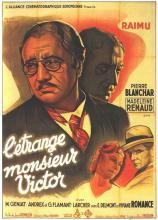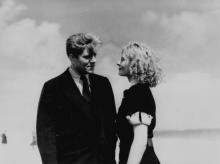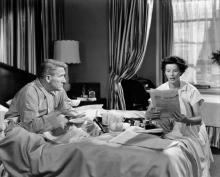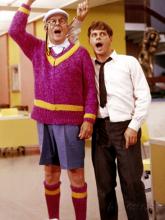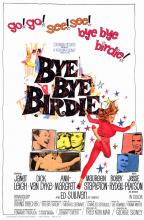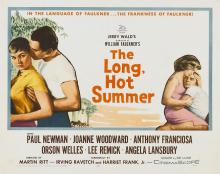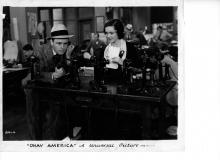These notes on Jean Grémillon's L'Étrange Monsieur Victor (The Strange Monsieur Victor, 1938) were written by Jonah Horwitz, Ph.D candidate in UW Madison's Department of Communication Arts. A 35mm print of Monsieur Victor will screen in the Cinematheque's regular location, 4070 Vilas Hall, on Saturday, September 26 at 7 p.m.
By Jonah Horwitz
L’Étrange Monsieur Victor is the second film in the UW Cinematheque’s series to represent its director Jean Grémillon in what might be called his "mature" phase, spanning 1937 to 1951. During this time, he worked in established genres within France’s star system and largely sublimated his experimental impulses in a sophisticated classical style. This was also the period of his greatest commercial success and critical renown.
After several early-1930s commercial failures (all combining melodramatic plotlines with outré style), Grémillon was essentially unemployable in the French film industry. From 1932 to 1934, he made several short films and a feature in Spain. Grémillon’s redemption came in late 1934, when he met Raoul Ploquin, then head of French-language production for the German film powerhouse UFA. Ploquin entrusted Grémillon to take charge of a film-operetta, Valse royale ("Royal Waltz," 1935)—the French version of the German film Königswalzer. This assignment led to his next film, Pattes de mouche ("Scrawl," 1936), an adaptation of a 19th-century theatrical play. Neither of these films was especially successful, but their adherence to generic formulae at least proved—above all, to Ploquin—that Grémillon was a director he could trust with bigger stars and bigger budgets.
That trust paid off with Gueule d’amour (literally "Lover Lips," but frequently translated as "Lady Killer"), which reunited Jean Gabin and Mireille Balin, luminous stars of Pépé le Moko. Gueule was the last of three masterpieces from 1937—after Pépé and La grande Illusion—to establish Gabin’s classic persona of a world-weary, working-class anti-hero undone (or nearly) by sentiment. Gueule d’amour is no less adventurous than Grémillon’s early sound features, but his experimental impulses are channelled into a confident, classical style. The film’s shifts in tone and its establishment of mood are achieved subtly and delicately. The sonic disjunctures and startling images of La petite Lise and Daïnah la métisse appear sparingly in Grémillon’s later features, which compensate for this "lack" with a richness of texture and elaborately evolving narratives.
L’Étrange Monsieur Victor ("The Strange Mr. Victor") was Grémillon’s first film after Gueule d’amour, and it shows how his "mature" style can express complex shadings of character. As with Grémillon’s other UFA productions, the interiors were shot in a Berlin studio and exteriors on location—in this case Toulon in southern France. Grémillon again worked with the great screenwriter Charles Spaak, who had previously written La petite Lise and Gueule d’amour (among many other great French films of the 1930s). The star—and the film is very much a star vehicle—was Raimu. Born Jule Auguste Muraire in Toulon, Raimu was an admired stage actor who had achieved international fame for starring in a series of films adapted from Marcel Pagnol’s plays: Marius, Fanny, and César (1931–36). Raimu was strongly associated with southern France and viewed as a somewhat "rugged" type, although as Mr. Victor he’s playing partially against type.
Note: those opposed to spoilers might wish to skip the remainder of this piece until after they’ve seen the film. However, I’ve tried to keep mum on the most surprising plot developments.
L’Étrange Monsieur Victor has a dynamite set-up: Mr. Victor, a successful merchant, happily-married new father, and pillar of his Toulon neighborhood, moonlights as a fence for a gang of robbers. This opposition—between bourgeois respectability and crime, or what we might call "family values" and pure avarice—is deepened as the film goes on. Mr. Victor kills an accomplice who threatens to blackmail the gang, and allows an innocent shoemaker (Pierre Blanchar) to go to prison for the murder. Later, the shoemaker breaks free and returns to Toulon, seeking the help of none other than Mr. Victor, whom he does not know to be the true culprit. From this point the movie—which earlier has qualities of a both a noir and a farce—becomes a chamber drama, among Mr. Victor, his wife (Remorques's Madeleine Renaud), and the shoemaker.
The most distinctive aspect of L’Étrange Monsieur Victor is likely the filmmakers’ unwillingness to establish who Mr. Victor "really" is: loving family man or cold-blooded murderer. He is, disturbingly, both. Sellier describes how the film’s moral contradictions were developed by Spaak and Grémillon across several drafts of the script. In earlier versions, Mr. Victor shows remorse for his crime; indeed, in one draft he leaves a full confession on his deathbed. Interim versions attempt to mitigate the awfulness of his crime. These gestures to a conventional moralism were gradually stripped away, and Sellier observes that in the final draft, Victor’s "mix of generosity and cynicism" is never reconciled. He remains capable of the greatest tenderness and the greatest cruelty. Raimu’s remarkable achievement is to make both seem plausibly the work of the same man. Arguably, the relative seamlessness of Grémillon’s style aids this portrayal; a more aggressive, disruptive display of technique might have unnecessarily underlined Mr. Victor’s contradictions.
As with Jean Renoir’s La Règle du jeu (1939), it’s tempting to interpret the characterizations in L’Étrange Monsieur Victor as anticipating the horrors of World War II. Certainly, the theme of bourgeois respectability harboring the basest impulses would become painfully relevant in years to come. But I’m not sure we need to credit Grémillon and Spaak with clairvoyance to appreciate the audacity of the film’s conception and the seductiveness of its style.

